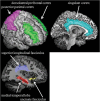Physical activity predicts microstructural integrity in memory-related networks in very old adults
- PMID: 24474004
- PMCID: PMC4172036
- DOI: 10.1093/gerona/glt287
Physical activity predicts microstructural integrity in memory-related networks in very old adults
Abstract
Background: Although the beneficial effects of physical activity (PA) on memory and executive function are well established in older adults, little is known about the relationship between PA and brain microstructure and the contributions of physical functional limitations and chronic diseases. This study examined whether higher PA would be longitudinally associated with greater microstructural integrity in memory- and executive function-related networks and whether these associations would be independent of physical function and chronic diseases.
Methods: Diffusion tensor imaging was obtained in 2006-2008 in 276 participants (mean age = 83.0 years, 58.7% female, 41.3% black) with PA (sedentary, lifestyle active, and exercise active) measured in 1997-1998. Gait speed, cognition, depressive symptoms, cardiovascular and pulmonary diseases, hypertension, stroke, and diabetes were measured at both time points. Mean diffusivity and fractional anisotropy were computed from normal-appearing gray and white matter in frontoparietal and subcortical networks. Moderating effects of physical function and chronic diseases were tested using hierarchical regression models.
Results: Compared with the sedentary, the exercise active group had lower mean diffusivity in the medial temporal lobe and the cingulate cortex (β, p values: -.405, .023 and -.497, .006, respectively), independent of age, sex, and race. Associations remained independent of other variables, although they were attenuated after adjustment for diabetes. Associations between PA and other neuroimaging markers were not significant.
Conclusions: Being exercise active predicts greater memory-related microstructural integrity in older adults. Future studies in older adults with diabetes are warranted to examine the neuroprotective effect of PA in these networks.
Keywords: Brain aging; Epidemiology.; Neuroimaging; Physical activity.
© The Author 2014. Published by Oxford University Press on behalf of The Gerontological Society of America. All rights reserved. For permissions, please e-mail: journals.permissions@oup.com.
References
-
- Pantano P, Baron JC, Lebrun-Grandié P, Duquesnoy N, Bousser MG, Comar D. Regional cerebral blood flow and oxygen consumption in human aging. Stroke. 1984;15(4):635–641 - PubMed
-
- Buckner RL. Memory and executive function in aging and AD: multiple factors that cause decline and reserve factors that compensate. Neuron. 2004;44(1):195–208. :10.1016/j.neuron.2004.09.006 - PubMed
-
- Kerr AL, Steuer EL, Pochtarev V, Swain RA. Angiogenesis but not neurogenesis is critical for normal learning and memory acquisition. Neuroscience. 2010;171:214–226. :10.1016/j.neuroscience.2010.08.008 - PubMed
Publication types
MeSH terms
Grants and funding
- P30 AG024827/AG/NIA NIH HHS/United States
- N01-AG-6-2101/AG/NIA NIH HHS/United States
- R01-NR012459/NR/NINR NIH HHS/United States
- R01 NR012459/NR/NINR NIH HHS/United States
- K23-AG028966-01/AG/NIA NIH HHS/United States
- P30-AG024827/AG/NIA NIH HHS/United States
- N01-AG-6-2106/AG/NIA NIH HHS/United States
- R01 AG029232/AG/NIA NIH HHS/United States
- R01 AG037451/AG/NIA NIH HHS/United States
- UL1 TR000005/TR/NCATS NIH HHS/United States
- R01-AG028050/AG/NIA NIH HHS/United States
- R01-AG029232/AG/NIA NIH HHS/United States
- N01 AG062101/AG/NIA NIH HHS/United States
- N01-AG-6-2103/AG/NIA NIH HHS/United States
- K23 AG028966/AG/NIA NIH HHS/United States
- R01 AG028050/AG/NIA NIH HHS/United States
- ImNIH/Intramural NIH HHS/United States
LinkOut - more resources
Full Text Sources
Other Literature Sources
Medical


